The well-known analyst and researcher of Russian space programs Bart Hendricks (Bart Hendrickx) published on the resource "The Space Review" interesting material "Soviet television reconnaissance satellites" ("Soviet television reconnaissance satellites").
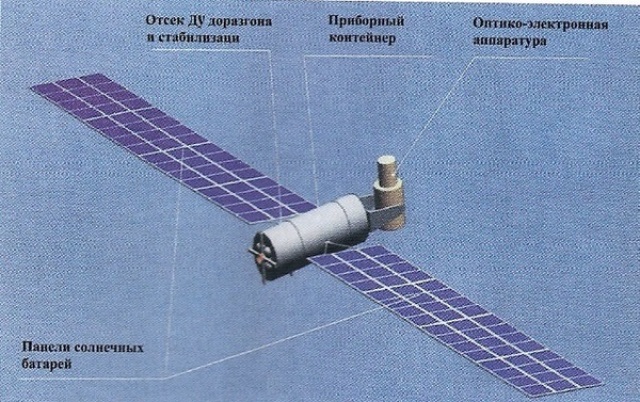
One of the variants of the satellite project of the "Television Global Intelligence" (TGR) system, developed by V.N. Chelomey's OKB-52 in the 1960s (with) NPO Mashinostroeniya
Beginning in the early 1960s, the Soviet Union launched hundreds of photo-reconnaissance satellites that returned the captured film back to Earth in capsules. It was only in 1982 that the country launched its first electron-optical reconnaissance satellite into orbit, capable of sending images to Earth in almost real time. As a temporary measure, proposals were put forward in the 1960s and 1970s to achieve the same goal through the use of reconnaissance satellites with television cameras. Such cameras were eventually installed on two unmanned versions of the Almaz military space station in the late 1980s and early 1990s, but by that time the technology was already outdated. Although some information about these projects has appeared in about the last 20 years, their details remain sketchy.
Film reading systems
The obvious disadvantages of satellites with a film return system were the limited supply of film they could carry (and therefore their limited service life) and, more importantly, their inability to transmit images in a timely manner. The Soviet Union made its first attempts to transmit images to Earth via radio channels using first-generation photo-reconnaissance satellites called Zenit-2, which, in fact, were unmanned versions of the Vostok spacecraft stuffed with cameras. Four of these satellites, launched in 1962-1963, had an experimental film reading system called Baikal, which scanned the film automatically developed on board and transmitted the images to Earth. A similar method was used by the Luna-3 probe in 1959 to send the first images of the far side of the Moon to Earth. However, the images obtained using the Baikal system had a resolution of about 10 meters, which was not enough to provide valuable intelligence information. As a result, this payload was removed from subsequent Zenit-2 satellites.
A similar film reading system tested on the US Air Force's Samos reconnaissance satellite in 1961 suffered the same fate (although the technology was transferred to NASA for use in the Lunar Orbiter program). Later that decade, the Pentagon approved the development of a variant of the GAMBIT reconnaissance satellites equipped with a film reading system known as the GAMBIT Film Read-Out (FROG). In 1971, it was canceled in favor of the first electron-optical reconnaissance satellite, which made its first flight in 1976 under the code name KENNEN.
The first draft of the TGR
Since the technology of reading films did not give any prospects, the Soviet designers decided to go another way to speed up the acquisition of reconnaissance images, namely to equip reconnaissance satellites with television cameras. The United States pioneered this technology with the world's first weather satellite, TIROS-1, launched in April 1960. TIROS was actually developed from a reconnaissance satellite project, which was rejected because the resolution of the television cameras was worse than the resolution of the photographic camera system.
The initiative to create television intelligence satellites in the USSR reportedly came from the head of OKB-52 Vladimir Chelomey. Initially specializing in anti-ship cruise missiles, in the late 1950s and early 1960s, this bureau switched to the development of space rockets and military satellites. According to one source, Chelomey managed to convince Soviet leader Nikita Khrushchev that he could develop a satellite system capable of transmitting television images of important areas directly to the Kremlin. At that time, the Soviet Union was concerned about the deployment of American Minuteman intercontinental ballistic missiles and Polaris submarine ballistic missiles, as well as the presence of an impressive fleet of American strategic bombers, many of which patrolled around the clock near the borders of the Soviet Union. If there were any signs of an imminent attack on the USSR, the reaction would have to be quick.
On September 4, 1963, the Central Committee of the CPSU and the Soviet government issued a decree ordering OKB-52 to develop a system of "Television Global Intelligence" (TGR) within five to seven years. It was an ambitious project that required the cooperation of organizations belonging to five different ministries. The main subcontractor of OKB-52 for the project was NII-380 in Leningrad, which began work on a television payload codenamed "Bumblebee".
In September 1965, OKB-52 completed a preliminary conceptual study of the TGR. In order to provide almost continuous coverage of the regions of interest, a grouping of four satellites had to rotate around the Earth in sun-synchronous orbits at an altitude of about 320 kilometers and with an inclination of 96-97 degrees (other orbital configurations were also being worked out). The satellites were supposed to save the image on video recorders and transmit it to three ground stations, which, in turn, would forward them to a single data processing center.
The objects of observation were to be bases of intercontinental ballistic missiles and strategic bombers, US Navy ships, ground combat complexes, major ports, railways and transport hubs. Since the main purpose of the TGR, obviously, was to detect the preparation of an enemy attack on Soviet territory, the satellites did not need to have a very high resolution required for technical reconnaissance of weapons systems. Television cameras were to be equipped with vidicons - small tubes that would capture images by scanning a photoconductive surface with an electron beam. To ensure the necessary resolution, they were combined with modern optical systems developed by the State Institute of Applied Optics (GIPO) and the Krasnogorsk Mechanical Plant (KMZ).
Two satellite configurations are described in sufficient detail: one with a double payload for conducting ground and sea reconnaissance, and the other with a single payload for conducting ground reconnaissance. In its first configuration, the satellite had a catadioptric optical system (using a combination of lenses and mirrors) called "Comet-11" with a focal length of 6.5 meters and a ground resolution of 1.5 to 2.5 meters for ground observations. The payload for conducting marine reconnaissance was called "Mars" and had a focal length of 1.6 meters and an area resolution of 5 to 10 meters. There should also be an electronic (radio) intelligence system on board to detect ships. The second version had a Photon-4 lens with a focal length of 4.5 meters and an area resolution of 3.5 to 4 meters.
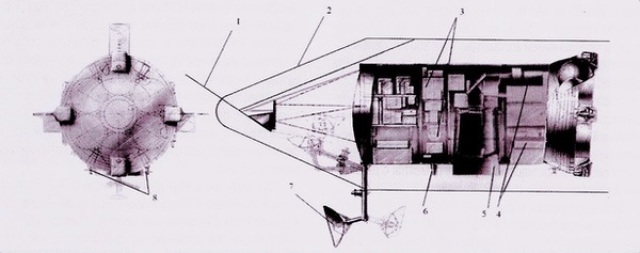
A TGR satellite for conducting ground and sea reconnaissance in the launch configuration. Designations: 1. Radio intelligence antenna; 2. Payload casing; 3. Payload for marine reconnaissance "Mars"; 4. Television equipment; 5. "Comet-11" system; 6. Infrared vertical sensor; 7. Antenna of the descending communication line (with) NPO Mechanical Engineering
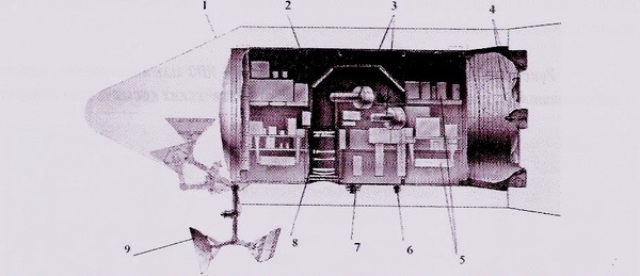
A TGR satellite for conducting ground reconnaissance in the launch configuration. (Photo: NPO Mashinostroeniya). Designations: 1. Payload casing; 2. Equipment container; 3. Television equipment; 4. Fuel tanks; 5. On-board control system; 6. Infrared vertical sensor; 7. Antenna (purpose unknown); 8. Photon-4 lens; 9. Downlink antenna (c) NGO of Mechanical Engineering
Another design of the THR Chelomey satellite is shown in the figure in the splash screen of this article, which indicates that many concepts have been studied. This is the only available illustration showing the satellite in its orbital configuration. On it, the optical payload is mounted perpendicular to the body of the satellite and, apparently, could tilt. Huge solar panels stretched on both sides of the satellite and supplied electricity to its energy-intensive television load. An onboard nuclear reactor was also considered, not much different from the one already being developed at that time for ocean reconnaissance satellites (MCRS), which would use radar to determine the location of foreign warships. The TGR satellites weighing about 10 tons were to be launched using a two-stage version of the Chelomey UR-500 launch vehicle/"Proton", which made its first flight in July 1965.
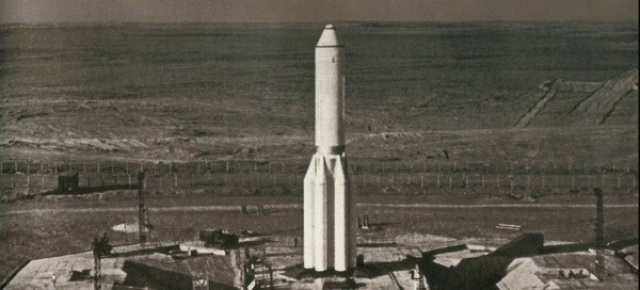
The original two-stage version of the Proton launch vehicle (c) NPO Mashinostroeniya
In a conceptual study (R&D) completed in September 1965, it was noted that, although there are good chances of developing a payload for low-resolution maritime reconnaissance in a relatively short period of time, it will take much longer to create high-resolution ground reconnaissance systems. Meanwhile, political turmoil and interdepartmental disagreements threatened to stop the implementation of the project. The Chelomey Bureau lost most of the political support it enjoyed from the Kremlin after Khrushchev's overthrow in October 1964. As part of a major shake-up of the Soviet space industry in 1965, Chelomey was forced to relinquish control over three of his military satellite projects (marine reconnaissance satellites, early warning and interceptors) in favor of Anatoly Savin's OKB-41, which was part of a larger organization called KB-1, subordinate to another ministry. OKB-41 has already acted as a subcontractor for OKB-52 military satellites (including TGR), responsible for on-board and ground control systems. Now the roles have changed.
Although the TGR remained in the hands of OKB-52, OKB-41 came up with an alternative proposal for a satellite system. According to the History of the Russian Military Space Forces, the proposals of both design bureaus were considered by an interdepartmental commission, which "failed to take an independent and objective position" in what it described as a "fierce struggle" for a leading role in the project between the two ministries. As a result, the work on the TGR gradually came to a standstill. Another reason for the premature completion of the project was the fact that the "scientific, technical and industrial base" of the Soviet Union at that time was simply not ready for a project of such complexity. Russian sources do not name the exact date of cancellation of the TGR project.
The Chelomey TGR project in reality led to one important side result. The Comet-11 optical system was modified for use on the Almaz military space station, conceived by OKB-52 in 1964 as a response to the project of the American Manned orbital military station Manned Orbiting Laboratory (MOL). Named "Comet-11a", this system had a focal length of 6.375 meters and a mirror with a diameter of 0.88 meters and became part of a large complex of cameras known as "Agat-1", which occupied a significant part of the interior space of the Almaz station.
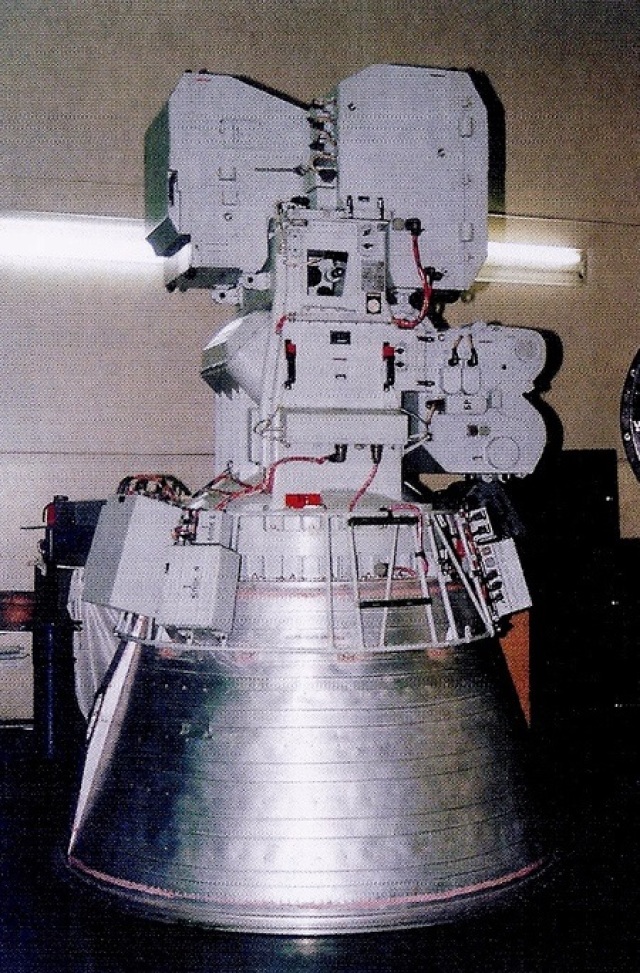
Agat-1 Chamber Complex (c) NPO Mashinostroeniya
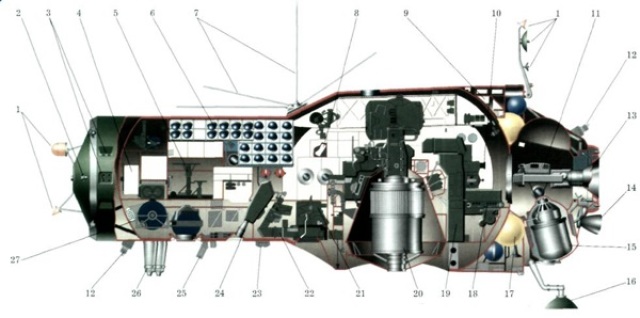
The Agat-1 camera complex can be seen at position 20 in this drawing of the Almaz space Station in the section (C) www.gctc.ru
Most of the images obtained by the Agat-1 complex were delivered to Earth in film return capsules installed on board the stations. However, the astronauts could also view the most interesting images on board and transmit them to ground stations using a film reading system ("Pechora"), which was also considered by the Americans for MOL tasks. Unlike the remaining MOL in the project, Almaz was still put into orbit. Three such stations were launched under the names "Salyut-2" (1973), "Salyut-3" (1974) and "Salyut-5" (1976). While Salyut-2 failed before the arrival of the first crew, one and two crews visited Salyut-3 and Salyut-5, respectively.
The second project of the TGR
On October 15, 1971, the Soviet government issued a decree ordering the resumption of work on television intelligence satellites. Russian sources did not explain the reasons for this, but even at that time, satellites with electron-optical imaging using CCD technology remained such a distant dream for the Soviet Union that it seemed appropriate to give the TGR another chance. The fact that this decision was made simultaneously with the top-secret decision of the United States at the end of 1971 to continue the development of KENNEN satellites was almost certainly a coincidence. Nevertheless, the Soviet planners were undoubtedly aware of the fact that the American microelectronic industry was far ahead, and must have realized that the United States would deploy such satellites much earlier. Therefore, some kind of response was needed to bridge the gap with the creation of their own electron-optical reconnaissance satellites in the Soviet Union.
Another factor that could play a role was the too high intensity of the launch of Soviet satellites with a film return system. Despite the improved characteristics of the Zenit satellites, they could remain in orbit for no more than two weeks, which required a large number of launches to ensure continuous coverage of critical areas. Only in 1971, about 30 Zenit-class satellites were put into orbit. The TGR satellites could at least slightly ease the heavy load that satellites with a film return system placed on the Soviet space industry.
By the decree of October 15, 1971, the project of the new TGR was entrusted to two design bureaus - Yuzhnoye Design Bureau and OKB-41. Yuzhnoye Design Bureau is a design bureau based in Dnepropetrovsk (Ukraine), which was headed by Mikhail Yangel until his death on October 25, 1971, just ten days after the release of the new resolution of the TGR (he was replaced by Vladimir Utkin). It was founded as OKB-586 in 1954 to create a new generation of medium- and intercontinental-range ballistic missiles, and since the early 1960s it has also been tasked with developing a wide range of satellites for both military and scientific purposes. OKB-41, which was still headed by Anatoly Savin, separated from KB-1 in 1973 and in 1973 became an independent Central Research Institute "Comet".
Sources provide contradictory information on this project. K.A. Vlasko-Vlasov [former chief designer of the Central Research Institute "Comet", author of the book "From "Comet" to "Eye"] claims that the 1971 decree did not appoint a general contractor and that the Yuzhnoye Design Bureau and OKB-41 were asked to develop their concepts on on a competitive basis. According to Vlasko-Vlasov, Yuzhnoye Design Bureau proposed a ten-ton satellite that had to be launched by a Proton launch vehicle, while the proposed OKB-41 satellite weighed no more than five tons, remaining within the launch capacity of a Soyuz-type launch vehicle. Both satellites were supposed to receive energy from a nuclear reactor, but later the Yuzhnoye Design Bureau switched to solar panels and reduced the mass to "just under 10 tons". The innovations of the OKB-41 satellite included a television system using some early CCD technologies, the use of integrated circuits and microprocessors, as well as a digital recorder for storing the received images.
According to Vlasko-Vlasov, the OKB-41 satellite with its smaller mass and expanded technical characteristics seemed an obvious choice. However, according to him, the interdepartmental commission, which was tasked with choosing one of the two proposals, "began to look for flaws" in the OKB-41 proposal, one of which was that radiation emitted by a nuclear reactor could affect on-board television systems. OKB-41 joined forces with the Kurchatov Institute of Atomic Energy to prove that the problem can be solved with the help of a special radiation-resistant optical glass. Nevertheless, the commission opted for the proposal of the Yuzhnoye Design Bureau, and although some elements of the OKB-41 proposal were used in its project, the latter Design Bureau was forbidden to conduct further work on the TGR system. According to Vlasko-Vlasov, this "incomprehensible decision" led to the fact that the project was finally curtailed after just three years.
The official history of Yuzhnoye Design Bureau, in which OKB-41's participation in the project is mentioned only in passing, confirms that the initial project of Yuzhnoye was to create a satellite with a nuclear installation equipped with elements such as an electric propulsion system, a highly efficient temperature control system and an autonomous navigation system. When the military customer got acquainted with the draft design of the Yuzhnoye Design Bureau, he came to the conclusion that the development of a nuclear reactor had not progressed far enough for it to be used at the initial stage of the project. Instead, the satellites will have to rely on solar energy, although this will affect some of their operational capabilities.
Yuzhnoye Design Bureau subsequently redesigned the satellite "in a short time", and its smaller mass now made it compatible with the new medium-payload launch vehicle, on which the bureau worked under the index 11K77, which eliminated the need to use the more expensive Proton. After several design changes, the launch vehicle was approved in March 1976 and later became known to the world as Zenit (not to be confused with the reconnaissance satellites of the same name).
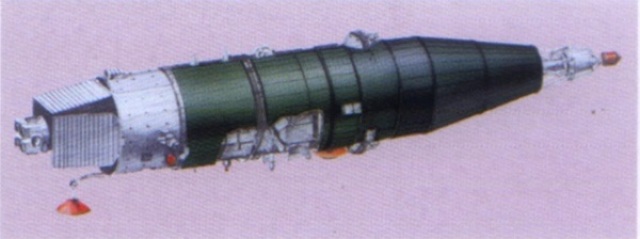
Nuclear version of the TGR satellite developed by Yuzhnoye Design Bureau (c) Yuzhnoye Design Bureau
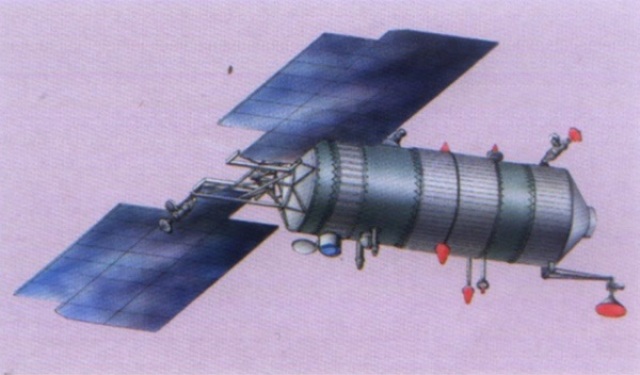
A version of the TGR satellite with solar panels developed by Yuzhnoye Design Bureau (c) Yuzhnoye Design Bureau
In the history of Yuzhny, it is said that the redesigned Yuzhnoye Design Bureau satellite project was given preference over the OKB-41 proposal, adding that by that time OKB-41 was appointed the parent organization for the TGR, and Yuzhnoye Design Bureau was responsible for the "rocket and space complex". The termination of the participation of the Yuzhnoye Design Bureau in the TGR there is associated only with the heavy workload of the Design Bureau, without specifying when exactly the Design Bureau left the project.
With only two biased versions, it is difficult to reconstruct the true story of the second project of the TGR. Most likely, OKB-41 was supposed to play the same role in the TGR that it acquired in a number of other military space projects in 1965. It acted as the lead organization for these projects, but had no production facilities for the production of satellites, limiting itself mainly to the development of on-board control systems and ground control equipment. As a result, the production of satellites had to be entrusted to other organizations.
A similar division of labor was apparently envisaged for the second TGR project: OKB-41 was the general contractor, and Yuzhnoye Design Bureau was engaged in the supply of a launch vehicle and a satellite platform ("rocket and space complex", as it is called in the history of Yuzhnoye). It seems that both proposed competitive projects for the TGR, from which the design of the Yuzhnoye Design Bureau was eventually chosen. An important factor in this decision may have been the transition of Yuzhny from a nuclear satellite to a satellite with solar energy - a step that OKB-41, apparently, did not take.
Almaz-T
The second TGR project was officially terminated by a decree of the Soviet Government on January 19, 1976. Exactly on the same day, a resolution was adopted that determined the schedule for the implementation of the Almaz Chelomey project for subsequent years. Most likely, it was the same resolution that closed the TGR. Among other things, it was about the development of two automated versions of Almaz (Almaz-K and Almaz-T), which could perform tasks beyond the capabilities of smaller reconnaissance satellites of that time.
Almaz-K was supposed to take panoramic pictures of large territories in high resolution, mainly for monitoring local conflicts and crisis situations. Being in orbit for about three months, he had to regularly send the exposed film in 16-20 return capsules. Almaz-T was supposed to be able to conduct reconnaissance through clouds and at night, using both a radar system and an infrared payload. In addition to this, it had to be equipped with a television system based on the one that was originally planned for the second project of the TGR. All these payloads were supposed to transmit images over radio channels, ensuring that the data would fall into the hands of image decryption specialists within a few hours after they were received. The main task of Almaz-T was to search for potential signs of an imminent attack on Soviet territory by carefully monitoring airfields, naval bases, transport hubs, and other strategically important targets. In fact, it was supposed to perform the same function as the TGR, but the 20-ton mass of the device allowed it to be done with a wider set of remote sensing devices operating in various parts of the electromagnetic spectrum.
With the approval of the Almaz-T project and its television payload, television intelligence returned to the Chelomey Design Bureau, which in 1966 was renamed the Central Design Bureau of Mechanical Engineering (CCBM). The Almaz-T television payload was called "Leader" and was created by an industrial association under the leadership of the All-Union Scientific Research Institute of Television (VNIIT) in Leningrad, the same institute that worked on the initial project of the TGR in Leningrad in the 1960s under the name NII-380. Igor Valik, a veteran of VNIIT, who also led the development of the Baikal and Pechora film reading systems, became the head of the Leader ROC. According to the history of VNIIT, the institute began work on the "Leader" in 1973, which suggests that it was originally intended for flights on TGR satellites. However, it is possible that after the transfer of the project for use on Almaz-T, it underwent significant modifications.
The Leader occupied the same place where the Agat-1 camera complex was located at the Almaz manned stations, and looked at the Earth through a 40-centimeter porthole. His optical system, provided by the Krasnogorsk Mechanical Plant, was named "Emerald" and had a lens ("Teleguar-12MT") with a focal length of three meters. The light beam, entering the optical system, was divided into three parts by means of a set of mirrors and then entered three simultaneously working television cameras (LR-103) with vidicon tubes "Kolos" (manufactured by the Research Institute "Electron"). They worked in the red part of the visible spectrum (600-700 nanometers), and each had a resolution of 4000 lines. The images were recorded on a three-channel DVR (RD-101) manufactured by LOMO (Leningrad). When the spacecraft flew over Soviet territory, three separate images were transmitted to Earth, where they had to be combined into one image. The Leader was also able to send images directly to Earth (without recording them) if it was shooting while within range of Soviet ground stations. The Leader had a viewing lane 18 kilometers wide, but it could be increased to 500 kilometers by turning the spacecraft relative to the longitudinal axis. The resolution on the terrain varied from two to five meters, depending on the observation conditions.
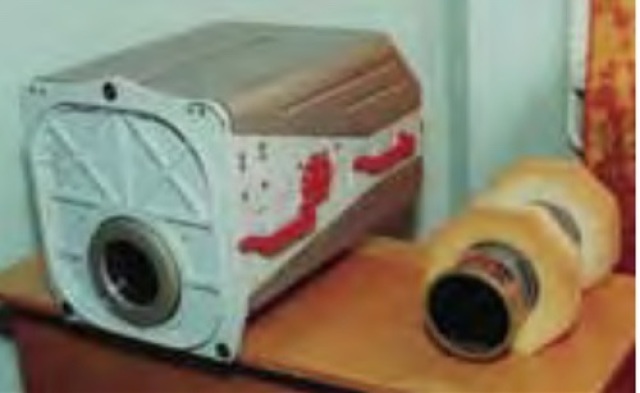
Fuzzy image of the LR-103 TV camera and its vidicon "Kolos" (c) NIIT
jpg">
Izumrud is an optical component of the Leader payload of the Almaz-T space station
In the resolution of January 1976, the goal was set to build three Almaz-T stations for test flights, starting in 1978. After the spacecraft was declared operational, it was assumed that three or six of them would simultaneously fly in three different orbital planes. However, by the end of the 1970s, the military's enthusiasm for Almaz had cooled significantly, one of the important reasons for which was the strained relations between Chelomey and the USSR Defense Minister Dmitry Ustinov. In June 1978, the USSR Ministry of Defense decided to stop work on the Almaz manned stations, and in December 1981 canceled both the Almaz-K and Almaz-T programs. The first Almaz-T station, which was already being prepared for launch at the Baikonur cosmodrome, was mothballed.
Ironically, Chelomey and Ustinov died almost simultaneously in December 1984, paving the way for the resumption of the Almaz-T project. Herbert Efremov, the new head of the design bureau (renamed NPO Mashinostroeniya in 1983), managed to convince the Soviet leadership to revive Almaz-T, claiming that the United States is leading in space radar monitoring of the Earth. After the unsuccessful launch of the first station on November 28, 1986, two stations were put into orbit on July 25, 1987 and March 31, 1991 under the official names "Cosmos-1870" and "Almaz-1". They were placed in low-altitude orbits with an inclination of 72 degrees, which provided better coverage of the Earth's surface than the orbits with an inclination of 51.6 degrees used by the manned Almaz stations. Kosmos-1870 spent two years in orbit, and Almaz-1 spent about one and a half years.
Publications of that time recognized only the presence of a radar system at these stations. The fact that the stations also had a television payload was not revealed until many years later (the originally planned infrared payload was apparently cancelled at an early stage). Nevertheless, even after more than three decades, very little is known about the characteristics of the "Leader", and none of the images he made have ever been published. It is reported that he made a large number of images for both military and civilian purposes and was able, among other things, to identify various types of aircraft on the ground.
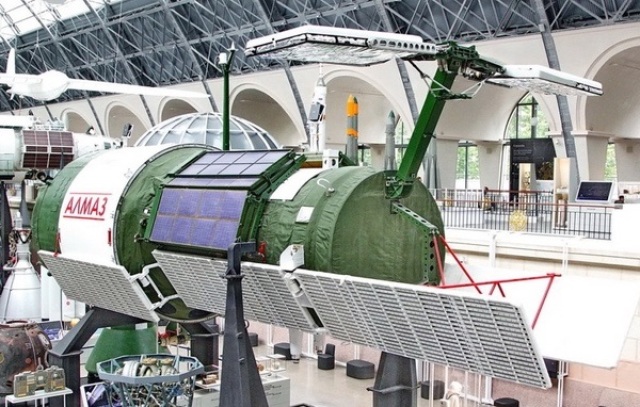
A model of the Almaz-T station with a radar antenna in the exposition of the Cosmos pavilion at VDNH in Moscow. A large antenna at the top was used to transmit images via data relay satellites (c) L. Kuznetsov / technomuzei.ru
By the time the long-delayed Almaz-T stations finally flew, the television technology was already outdated. In December 1982, the Soviet Union began launching electron-optical reconnaissance satellites with CCD technology. They had a similar or better resolution than the two-meter ground resolution offered by the Leader, and also sent images in almost real time via geostationary data relay satellites (a capability demonstrated only by Almaz-1).
Numerous publications suggest that the USSR Ministry of Defense has largely lost interest in Almazam-T and that the second station, in particular, was used mainly for civilian remote sensing. When Almaz-1 was taken out of orbit on October 17, 1992, the era of space television reconnaissance finally came to an end.
As the number of digital satellite launches increased, satellites with a film return system were gradually withdrawn from circulation, and the last of them was launched by Russia in 2015. However, so far Russia has not achieved the goal that the Soviet Union intended to achieve with the help of the TGR back in the 1960s, namely the deployment of a large fleet of simultaneously operating optical reconnaissance satellites capable of providing real-time reconnaissance and almost continuous coverage of important areas of the Earth. Currently, Russia apparently has only one operational high-resolution electron-optical reconnaissance satellite in orbit: Kosmos-2506 is a Person-type satellite. Having been launched in June 2015, it is likely to have significantly exceeded the design life.
